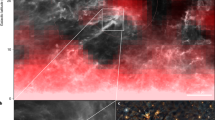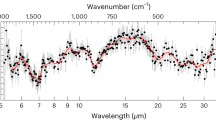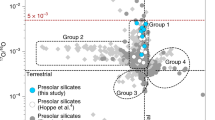Abstract
Astronomical observations show that early in their evolution, stars experience stages of high activity associated with enhanced energetic particle fluxes1. The Sun’s early activity is often inferred from the spallogenic isotope record (for example, 10Be) in the Solar System’s oldest materials2, calcium–aluminium-rich inclusions (CAIs) in meteorites3,4. However, the 10Be record could be affected by processes other than in situ irradiation by solar particles5. Noble gases can give less ambiguous insights because they are inert volatiles and hence not incorporated into CAIs during their formation6. Here we show that hibonite-rich CAIs, considered to have formed before 26Al-rich CAIs7,8, contain helium and neon excesses that can be unambiguously attributed to in situ irradiation by energetic particles. Given their volatile nature, we infer that the noble gases were produced by irradiation in a relatively cold region at a considerable distance from the Sun (not at the inner disk edge), requiring high particle fluxes and thus high early solar activity. Because more evolved CAIs lack comparable noble gas irradiation records9, we conclude that the oldest Solar System materials experienced a phase of intense irradiation not recorded by materials that formed later. Consequently, disk properties or energetic particle fluxes changed significantly during the very early phases of Solar System evolution.
This is a preview of subscription content, access via your institution
Access options
Access Nature and 54 other Nature Portfolio journals
Get Nature+, our best-value online-access subscription
$29.99 / 30 days
cancel any time
Subscribe to this journal
Receive 12 digital issues and online access to articles
$119.00 per year
only $9.92 per issue
Buy this article
- Purchase on Springer Link
- Instant access to full article PDF
Prices may be subject to local taxes which are calculated during checkout


Similar content being viewed by others
References
Feigelson, E. D. & Montmerle, T. High-energy processes in young stellar objects. Annu. Rev. Astron. Astrophys. 37, 363–408 (1999).
Connelly, J. N. et al. The absolute chronology and thermal processing of solids in the solar protoplanetary disk. Science 338, 651–655 (2012).
McKeegan, K. D., Chaussidon, M. & Robert, F. Incorporation of short-lived 10Be in a calcium–aluminum-rich inclusion from the Allende meteorite. Science 289, 1334–1337 (2000).
Sossi, P. A. et al. Early Solar System irradiation quantified by linked vanadium and beryllium isotope variations in meteorites. Nat. Astron. 1, 0055 (2017).
Liu, M.-C. & Chaussidon, M. in Boron Isotopes—The Fifth Element (eds Marschall, H. R. & Foster, G.) 273–289 (Advances in Isotope Geochemistry series, Springer, Cham, 2018).
Lodders, K., Palme, H. & Gail, H.-P. in Astronomy, Astrophysics, and Cosmology—Solar System (ed. Trümper, J. E.) Vol. 4B, Ch. 4.4 (Landolt-Börnstein: Numerical Data and Functional Relationships in Science and Technology series, Springer, Berlin, 2009); https://materials.springer.com/lb/docs/sm_lbs_978-3-540-88055-4_34
Liu, M.-C. et al. Isotopic records in CM hibonites: implications for timescales of mixing of isotope reservoirs in the solar nebula. Geochim. Cosmochim. Acta 73, 5051–5079 (2009).
Kööp, L. et al. A link between oxygen, calcium and titanium isotopes in 26Al-poor hibonite-rich CAIs from Murchison and implications for the heterogeneity of dust reservoirs in the solar nebula. Geochim. Cosmochim. Acta 189, 70–95 (2016).
Vogel, N., Baur, H., Bischoff, A., Leya, I. & Wieler, R. Noble gas studies in CAIs from CV3 chondrites: no evidence for primordial noble gases. Meteorit. Planet. Sci. 39, 767–778 (2004).
Ireland, T. R. Correlated morphological, chemical, and isotopic characteristics of hibonites from the Murchison carbonaceous chondrite. Geochim. Cosmochim. Acta 52, 2827–2839 (1988).
Sahijpal, S. & Goswami, J. N. Refractory phases in primitive meteorites devoid of 26Al and 41Ca: representative samples of first Solar System solids? Astrophys. J. Lett. 509, L137–L140 (1998).
Wood, J. A. Meteoritic evidence for the infall of large interstellar dust aggregates during the formation of the Solar System. Astrophys. J. Lett. 503, L101–L104 (1998).
Riebe, M. E. I. et al. Cosmogenic He and Ne in chondrules from clastic matrix and a lithic clast of Murchison: no pre-irradiation by the early Sun. Geochim. Cosmochim. Acta 213, 618–634 (2017).
Roth, A. S. G., Baur, H., Heber, V. S., Reusser, E. & Wieler, R. Cosmogenic helium and neon in individual chondrules from Allende and Murchison: implications for the precompaction exposure history of chondrules. Meteorit. Planet. Sci. 46, 989–1006 (2011).
Kööp, L. et al. New constraints on the relationship between 26Al and oxygen, calcium, and titanium isotopic variation in the early Solar System from a multielement isotopic study of spinel–hibonite inclusions. Geochim. Cosmochim. Acta 184, 151–172 (2016).
Kööp, L. et al. Calcium and titanium isotopes in refractory inclusions from CM, CO, and CR chondrites. Earth Planet. Sci. Lett. 489, 179–190 (2018).
Leya, I. & Masarik, J. Cosmogenic nuclides in stony meteorites revisited. Meteorit. Planet. Sci. 44, 1061–1086 (2009).
Trappitsch, R. & Leya, I. Solar cosmic-ray interaction with protoplanetary disks: production of short-lived radionuclides and amorphization of crystalline material. Meteorit. Planet. Sci. 48, 195–210 (2013).
Heck, P. R. et al. Interstellar residence times of presolar SiC dust grains from the Murchison carbonaceous meteorite. Astrophys. J. 698, 1155–1164 (2009).
Heber, V. S. et al. Noble gas composition of the solar wind as collected by the Genesis mission. Geochim. Cosmochim. Acta 73, 7414–7432 (2009).
Reedy, R. C. Solar-proton production of neon and argon. In Proc. 23rd Lunar and Planetary Science Conference 1133–1134 (Lunar and Planetary Institute, 1992).
Keller, L. P. & Berger, E. L. A transmission electron microscope study of Itokawa regolith grains. Earth Planets Sp. 66, 71–78 (2014).
Yang, L. & Ciesla, F. J. The effects of disk building on the distributions of refractory materials in the solar nebula. Meteorit. Planet. Sci. 47, 99–119 (2012).
Feigelson, E. D., Germire, G. P. & Pravdo, S. H. Magnetic flaring in the pre-main-sequence Sun and implications for the early Solar System. Astrophys. J. 572, 335–349 (2002).
Liu, M. C., & Nittler, L. R., & Alexander, C. M. O’D., & Lee, T. Lithium–beryllium–boron isotopic compositions in meteoritic hibonite: implications for origin of 10Be and early Solar System irradiation. Astrophys. J. Lett. 719, L99–L103 (2010).
Gounelle, M., Chaussidon, M. & Rollion-Bard, C. Variable and extreme irradiation conditions in the early Solar System inferred from the initial abundance of 10Be in Isheyevo CAIs. Astrophys. J. Lett. 763, L33 (2013).
Wielandt, D. et al. Evidence for multiple sources of 10Be in the early Solar System. Astrophys. J. Lett. 748, L25–L32 (2012).
Liu, M. C. & McKeegan, K. D. On an irradiation origin for magnesium isotope anomalies in meteoritic hibonite. Astrophys. J. Lett. 697, L145–L148 (2009).
Leya., I., Halliday, A. N. & Wieler, R. The predictable collateral consequences of nucleosynthesis by spallation reactions in the early Solar system. Astrophys. J. 594, 605–616 (2003).
Bjerkeli, P., van der Wiel, M. H. D., Harsono, D., Ramsey, J. P. & Jørgensen, J. K. Resolved images of a protostellar outflow driven by an extended disk wind. Nature 540, 406–409 (2016).
Ciesla, F. J. Residence times of particles in diffusive protoplanetary disk environments. I. Vertical motions. Astrophys. J. 723, 514–529 (2010).
Amari, S., Lewis, R. S. & Anders, E. Interstellar grains in meteorites: I. Isolation of SiC, graphite, and diamond; size distributions of SiC and graphite. Geochim. Cosmochim. Acta 58, 459–470 (1994).
Heck, P. R. et al. Presolar He and Ne isotopes in single circumstellar SiC grains. Astrophys. J. 656, 1208–1222 (2007).
Kööp, L. et al. Enhanced cosmogenic neon-21 and helium-3 in hibonite-rich CAIs. In Proc. 47th Lunar and Planetary Science Conference 1689 (Lunar and Planetary Institute, 2016).
Baur, H. A noble-gas mass spectrometer compressor source with two orders of magnitude improvement in sensitivity. Eos 46, F1118 (1999).
Farley, K. A. (U-Th)/He dating: techniques, calibrations, and applications. Rev. Mineral. Geochem. 47, 819–844 (2002).
Acknowledgements
We thank F. Ciesla, R. Trappitsch, T. Stephan and P. Boehnke for discussions. This work was supported by National Aeronautics and Space Administration through grants NNX15AF78G and 80NSSC17K0251 (to A.M.D.), a National Science Foundation Graduate Research Fellowship (grant numbers DGE-1144082 and DGE-1746045) (to J.G.) and an Ambizione Grant (PZ00P2_154874) from the Swiss National Science Foundation (to M.M.M.M.). H.B. acknowledges support from the ‘PlanetS’ National Center of Competence in Research (NCCR) of the Swiss National Science Foundation. P.R.H. and J.G. acknowledge funding from the Tawani Foundation.
Author information
Authors and Affiliations
Contributions
L.K. planned the study and classified and prepared samples. L.K., J.G. and P.R.H. performed noble gas measurements, with assistance from H.B., C.M. and M.M.M.M. All authors contributed to the interpretation and writing of the paper.
Corresponding author
Ethics declarations
Competing interests
The authors declare no competing interests.
Additional information
Publisher’s note: Springer Nature remains neutral with regard to jurisdictional claims in published maps and institutional affiliations.
Supplementary information
Supplementary Information
Supplementary Text, Supplementary Figures 1–4, Supplementary Tables 1–4, Supplementary References
Rights and permissions
About this article
Cite this article
Kööp, L., Heck, P.R., Busemann, H. et al. High early solar activity inferred from helium and neon excesses in the oldest meteorite inclusions. Nat Astron 2, 709–713 (2018). https://doi.org/10.1038/s41550-018-0527-8
Received:
Accepted:
Published:
Issue Date:
DOI: https://doi.org/10.1038/s41550-018-0527-8
This article is cited by
-
Particles and Photons as Drivers for Particle Release from the Surfaces of the Moon and Mercury
Space Science Reviews (2022)
-
Constraining the Evolutionary History of the Moon and the Inner Solar System: A Case for New Returned Lunar Samples
Space Science Reviews (2019)



